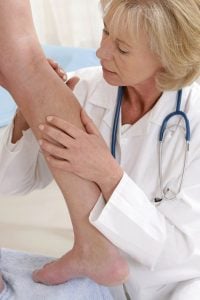Identifying Varicose Veins
Varicose veins are visibly enlarged veins that are most often seen on a person’s leg. The veins turn blue or purple and push on the skin, creating a bulge. The condition affects approximately 15% of men and 25% of women in the United States. Although they can appear anywhere along the length of the legs (from the ankle to the groin), they most frequently appear on the inside of the legs or on the rear of the calves. Spider veins are similar to varicose veins however they are smaller and appear closer to the skin.
Symptoms
High visibility, abnormally shaped veins, typically on your legs, are the main signs and symptoms of varicose veins. Additionally, you can experience discomfort, edema, heaviness, and achiness over or near the swollen veins.
You can have some edema and discolouration. In severe situations, ulcers may develop and the veins may bleed profusely.
Causes of Varicose Veins
Varicose veins are a result of blood pooling in the veins (usually in the legs and ankles). Blood can pool in the legs when the veins don’t have the ability to push it back up to the lungs and heart. Veins lose their ability to properly move blood when their valves or walls become weak or damaged. In healthy veins, the valves keep the blood flowing efficiently in one direction against the force of gravity up toward the heart. However if these valves stop functioning properly, blood will pool in the legs. Pressure will build and the veins will weaken, become enlarged and twisted.
Some people may be genetically predisposed to acquire varicose or spider veins. If someone in your family has spider or varicose veins, then you are more likely to develop them too. There are a variety of other factors that play a role in the acquisition of varicose and spider veins. They include:
- Being overweight
- Diabetes
- Hormone therapy
- Increased age
- Menopause
- Pregnancy
- Smoking
- Standing or sitting for long periods of time
Many of the above conditions place increased pressure on the veins in the legs. Simple changes in lifestyle can play a role in warding off vein diseases. Exercising and maintaining a healthy diet are a good place to start. Even a small to moderate amount of exercise that targets the legs can reveal large health benefits. By moving your legs, you are flexing your muscles which helps the veins push the blood uphill to the heart. Take a few minutes every hour or two to get up and move.
Treatment
Although we have stated numerous times that spider veins are harmless, some people may want to treat them for cosmetic reasons.
If you want to treat them, you can do it in a variety of ways, including:
Stockings with Compression
Compression stockings will be recommended by your doctor for early therapy. By raising the pressure on your legs, these stockings can help you maintain your blood circulation.
Additionally, it can help to minimize swelling and the danger of blood clots.
Sclerotherapy
Sclerotherapy is a common treatment for spider veins that involves injecting a chemical into the affected area. The chemical irritates and scars the inside of the vein, causing it to collapse and eventually disappear.
The veins normally fade away after 3 to 6 weeks, and you may need to repeat the procedure at least twice or three times for the best results.
Because this surgery takes so little time and is so unpleasant, anesthetic is not administered.
In addition, your doctor will enable you to return to work the next day.
Can genetics cause varicose veins?
Genetics can play a significant role in the development of varicose veins. While lifestyle factors such as prolonged standing, obesity, and lack of exercise can contribute to their formation, studies have shown that a genetic predisposition is a key factor.
Varicose veins are typically caused by a condition known as venous insufficiency, which occurs when the valves within the veins that help regulate blood flow become weakened or damaged. This can result in blood pooling in the veins and causing them to become enlarged, twisted, and visible under the skin.
Research has indicated that certain genes can influence the structural integrity of the vein walls and the functioning of the valves. If you have a family history of varicose veins, you are more likely to develop them yourself. It has been observed that approximately 50% of individuals with varicose veins have a family history of the condition.
While genetics can increase the risk of developing varicose veins, it does not guarantee their occurrence. Environmental factors and lifestyle choices also contribute to their development. Therefore, even if you have a genetic predisposition, adopting a healthy lifestyle can help mitigate the risk and potentially delay or minimize the onset of varicose veins.
Can you prevent genetically caused varicose veins?
While you cannot prevent the genetic predisposition to varicose veins, you can take steps to reduce the likelihood of developing them or alleviate their severity. These steps include maintaining a healthy weight, staying physically active, avoiding prolonged periods of standing or sitting, wearing compression stockings, elevating your legs when resting, and avoiding tight clothing that restricts blood flow. These measures can help improve blood circulation and minimize the symptoms associated with varicose veins. However, it’s important to note that if you have a genetic predisposition, it may be challenging to completely prevent their occurrence, but these lifestyle choices can be helpful in managing the condition.

